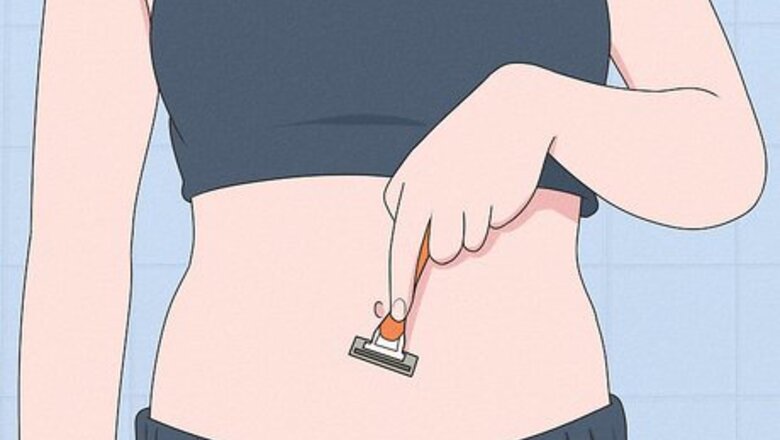
views
Using Quick Removal Systems
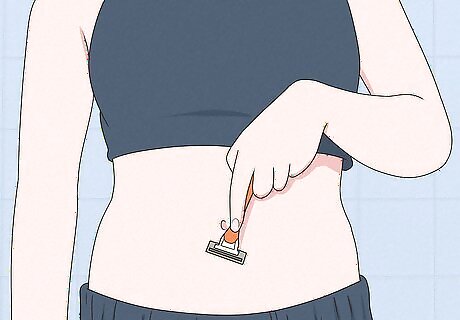
Shave your stomach. One of the simplest ways in which to remove hair from your stomach is by shaving it. Shaving will quickly remove hair from your stomach, though it may require more frequent upkeep than other methods, depending on the texture and amount of hair. Only shave your stomach hair when your skin is wet, which can help soften the follicles, making removal easier. Only shave your stomach hair in the direction in which the hair grows. This can lessen irritation and the likelihood of cutting yourself. Use a clean razor with sharp blade to help prevent infection and likelihood of cutting yourself. Consider using an electric razor or clipper if your stomach hair is especially thick and copious.
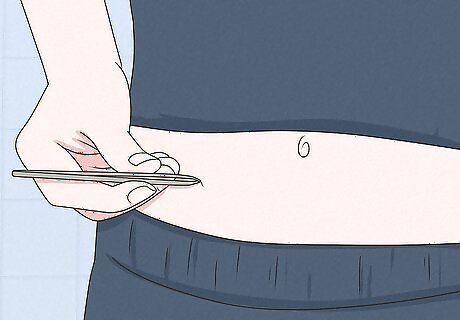
Pluck the hair. If you don’t have a large amount of hair on your stomach, you can simply pluck it either with tweezers or have someone pluck the hair by threading. These methods pluck the hair below the surface at the follicle and thus only require upkeep whenever new hair grows. You can pluck stomach hairs with tweezers or make an appointment at a local salon or spa that offers hair removal services. Threading, which is an ancient form of hair removal, rotates a looped piece of thread across the skin to pluck hairs. Inquire with local salon or spa if they offer threading services. Depending on where you live, it may be difficult to find a trained threader. Be aware that plucking and threading can be painful and irritate skin, though threading may be a better option for sensitive skin.
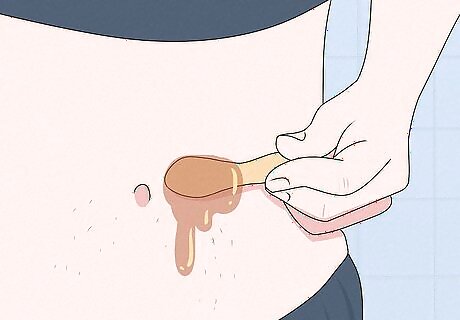
Wax or sugar your stomach area. Like plucking, waxing and sugaring remove hair at the follicle, which can hinder hair growth for longer than shaving. Waxing and sugaring can be very effective if a large portion of your stomach has hair and may also reduce overall growth if done over a longer period of time. Waxing involves applying a thin layer of warm, melted or cold wax to your skin and then pulling it off in the opposite direction of the hair growth. This uproots hair at the follicle. Like waxing, sugaring entails the application of a thin layer of heated sugar mixture that is then lifted off your skin to remove the hair. Sugaring may be a better option for more sensitive skin. Choose to wax or sugar yourself or have a professional remove stomach hair using these methods. Trim long or thick stomach hair before waxing or sugaring for better results and less pain. You can purchase home waxing and sugaring kits at many pharmacies. Most salons and spas will offer waxing and sugaring services, which can be expensive, but effective. Be aware that waxing and sugaring can be very painful, especially during initial treatments and on very sensitive stomach skin. In most cases, you’ll need to undergo treatments every 4-6 weeks to remove your stomach hair. Do or have a small skin test with a wax or sugar mixture to ensure that you don’t have an allergic reaction to it. In addition, you should never use wax or sugar on broken or inflamed skin because it can exacerbate irritation.
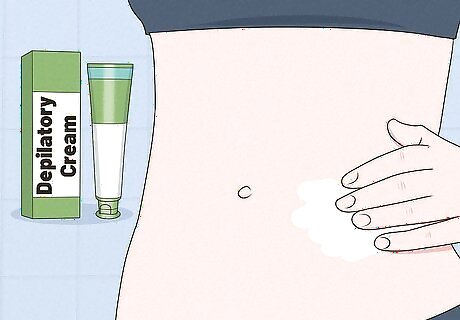
Apply a depilatory product. Depilatories are chemical formulations that break down the protein structure of hair and dissolve it into a jellylike mass. This can be a quick and painless way to remove stomach hair, especially if it is thick and spread across a wide area. Depilatories come in various forms including gels, creams, lotions, aerosols, and roll-ons. Because you are putting a chemical on your skin, it is important to first do a patch test to see if your skin reacts. You also shouldn’t use a depilatory on broken or inflamed skin. Apply the depilatory to the stomach hair you want to remove. Leave on the product for the length of time the packaging recommends and then wipe or rinse it off, along with the hair mass. If your skin burns at any time, remove the product immediately. Depilatory creams keep hair growth at bay for anywhere from 1 day to 10 days.
Undergoing Permanent Hair Removal
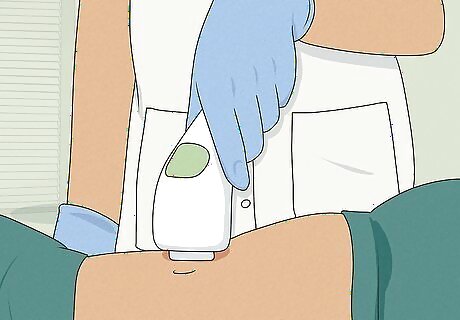
Have laser hair removal treatments. If you do not want to deal with stomach hair in the long run, get your hair removed with laser treatments, which use a pulse of light to destroy hair follicles. Although it requires multiple treatments, laser hair removal can provide extended hair-free periods or completed removal of your stomach hair. Laser hair removal is most effective on individuals with light skin and dark hair because it is easier for the laser to penetrate the hair follicle with these conditions. Laser hair removal is a medical procedure and should be done under the supervision of a doctor or trained professional for best results and to help minimize the risk of burning your skin. The number of treatments you require depends on how much hair you have. You may need four to six treatments scheduled approximately six weeks apart. Laser hair removal doesn’t always guarantee permanent hair removal and may require periodic maintenance treatments. The Food and Drug Administration has approved at-home laser devices for hair removal below the neck. Talk to your doctor to see if this is a viable option for you, knowing that performing laser treatments at home comes with significant risks.
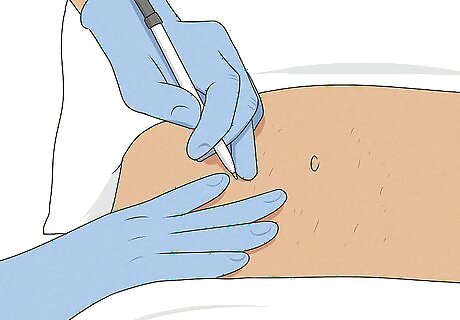
Get electrolysis. Like laser treatments, electrolysis is a medical procedure that destroys hair growth, though it uses shortwave radio instead of light. Electrolysis can effectively and permanently remove hair from your stomach area. Electrolysis involves a thin probe being placed under the skin and into the hair follicle. A pulse of shortwave radio is then sent through the probe to destroy the follicle. You will likely require a series of treatments over a period of time to fully remove your stomach hair. Have electrolysis done by a medical or trained electrolysis professional to minimize your risk of infection from unsterile needles or scarring from bad technique.
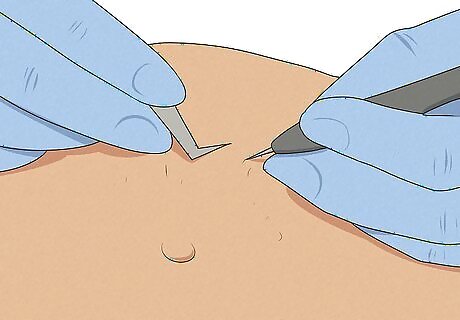
Epilate with needles. Similar to both lasers and electrolysis, needle epilation uses an electric current to destroy hair follicles. This can be an effective and permanent way to remove smaller amounts of stomach hair, though not necessarily practical for something who requires extensive removal. Needle epilation involves inserting a fine wire close to the hair shaft under the skin. Your doctor or epilation professional will then send an electric current down the wire to destroy the hair at the base of the follicle. After this, she may use tweezers to remove loosened hairs. You may also require a series of treatments with needle epilation to remove all of your stomach hair.

See your doctor. If your stomach hair is especially bothersome or doesn’t go away with treatments, it may be a sign of an underlying medical condition such as hirsutism. Schedule an appointment with your doctor to ensure that you do not have any condition that may be affecting the efficacy of your hair removal treatments. Hirsutism is a condition in women and some men that presents as unwanted male-pattern hair growth in women as a result of excess androgens including testosterone. Hypertrichosis is a condition that presents with excessive hair growth on some part of the body that is not related to androgens. There are few treatments available to persons with hypertrichosis and the results are often unsatisfactory. In most cases, doctors suggest hair removal procedures to alleviate excessive hair growth associated with hypertrichosis. If the skin has scars because hair is picked repeatedly in the area, you can use hydroquinone or retinol with a steroid.




















Comments
0 comment